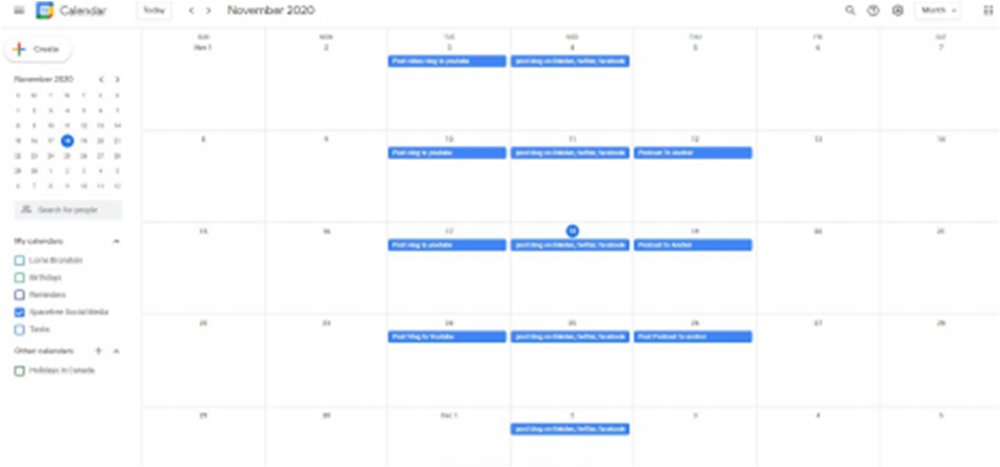In the age of social media, someone is always plugged in. Companies have adapted to this mindset by continuously providing a stream of social media content to keep their audience informed and entertained.
To maintain this level of communication, one must plan carefully or suffer the consequences of falling behind. Today, we’ll discuss the importance of a content plan and how anyone from a one-person business to a corporation can implement this strategy into their business.
Before we break down the steps of building a content plan, we must first establish what a content plan is.
What is a content plan?
A content plan, as the name suggests, is a calendar that businesses use to plan articles, posts, and events over a long period. The intention is to ensure that goals are met and prepared ahead of time. By having an outline of the content strategy for a month or even a year, you can develop it in advance and ensure you meet deadlines. While it may seem easy, creating content on a whim becomes overwhelming rather quickly. In addition to staying up to date, your brand voice changes depending on who’s writing the content.
Planning a social media content strategy ensures that you maintain consistency in post scheduling, stay up to date with current events, and, most importantly, maintain a consistent voice online. Consistency in brand voice builds confidence in users as they know what to expect.
Think of the biggest brands online. Coke, Disney, Apple – their voices never change. Whether you visit their page today or a year from now, you know what to expect. Audiences feel confident in a brand they can trust. Building a content plan that spans months or even a year ensures you maintain the same level of consistency as other successful businesses.
What goes into a content plan?
The first thing you need to do is establish your target audience. A target audience is the primary group of people your business is speaking, and it could be mothers aged 30 to 50 on Facebook or males 18 to 30 on Reddit. Many target audiences span across multiple social media platforms, and the type of content they view changes depending on what website they are visiting.
Instagram content excels when it’s short and to the point, while Youtube offers more leniency for long-form content. Understanding your target market is key to developing a content marketing strategy that engages your target audience in a way that matters to them most.
When developing a content calendar, ask yourself, “What’s the benefit of this content? What does it provide for the end-user?” If you have to think too hard, you need to rework it. The answer should be simple. All content should provide value in some way, be it informative or entertaining. The audience shouldn’t feel like they need to put in the effort to enjoy your content, or they will quickly tune out.
Staying relevant month to month
If you follow any popular brands, you will notice their social media content creation changes depending on the month. Around October, they post Halloween-themed content. Closer to December, they embrace the holiday season.
This content is no coincidence. A content calendar allows you to prepare in advance for holidays and embrace the spirit by meshing your business with the current monthly trends. Brands that focus on their customers instead of on sales have a much greater chance of building a connection. This connection strengthens the bond between them. The result is retention and positive word of mouth marketing. Have you ever been so pleased with a service you had to tell a friend? Most people have, and that’s because the brand left you with a positive experience. Anyone can replace grout, but few businesses make that experience not only painless but almost fun. By creating an experience and showing your customers there are humans behind the brand, you can build connections greater than just providing a service.
How to cover all platforms without burning out
Social media covers a wide array of websites from Youtube, Twitter, Facebook, Tiktok, and Snapchat. It seems a new social media platform emerges a few times a year. With so many platforms, it’s next to impossible for one person to keep up, let alone maintain an individual social media strategy for each. Instead of developing a content strategy for each platform, think of forms of content that can be shared across multiple platforms.
Let’s say you’re in the tiling business, and you want to show your customers how they can easily replace grout on their own. Youtube would be a great way to do this, but why not share that same video on Facebook and Twitter? Then, post a clip to Instagram with a “before and after” picture of the results.
Companies that share great content like this are far more likely to develop an interpersonal bond with their customers. Instead of speaking at them, which many users find condescending, start a conversation to share information they wouldn’t know otherwise. Your brand provides value for the customer they didn’t even know they needed. Next time they have an issue related to your industry, you will be on the top of their minds because you have already proven to them you not only provide value but are also competent and knowledgeable in the field. Taking one form of content and stretching it across multiple platforms ensures you cover the most ground possible, which is especially important while you’re still learning which platforms your target audience uses.
This concept may look overwhelming, but notice that all of this content can come from the same idea.
 Let’s say I write a post that’s going up on Facebook, Twitter, and Linkedin on Wednesday. I would create that blog the week prior. With that blog completed and waiting, I can read that blog on video and post that video to Youtube. I can take the audio from the video and publish that on Thursday as a podcast. I’ve now covered five social media platforms and three different avenues of content by producing one blog post.
Let’s say I write a post that’s going up on Facebook, Twitter, and Linkedin on Wednesday. I would create that blog the week prior. With that blog completed and waiting, I can read that blog on video and post that video to Youtube. I can take the audio from the video and publish that on Thursday as a podcast. I’ve now covered five social media platforms and three different avenues of content by producing one blog post.
The intention behind doing this is ensuring you speak to as many people as possible. Not everyone has time to watch Youtube videos or scroll Twitter, Instagram, and Facebook. Some people prefer to listen to a podcast on their way to work. Why don’t you cover as much ground as possible?
The content calendar helps you keep track of everything so you can focus on what matters most, creating content that provides value.


